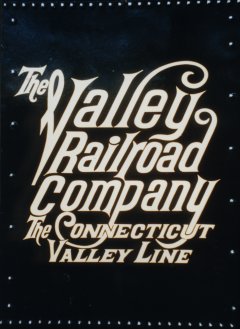Valley Railroad (Connecticut)
The Valley Railroad Company is a railroad based in Connecticut originally founded in 1868.
Contents
Construction
After one failed attempt to start, the Valley Railroad Company, headed by the President of the Charter Oak Life Insurance Company (James C. Walkeley), obtained the state charter to build and form this company on July 17, 1868.
During 1868-1869, survey crews worked to map out the line from Hartford to Saybrook Point, and in 1870, actual construction of the line began. With the ease of building a rail line in the Connecticut River Valley (no tunnels or major bridges), the line was completed during the summer of 1871 with the first ceremonial train run over the 45 mile line on July 29, 1871.
Two days later the first "regular" train was run and on August 24, 1871 the Connecticut Valley Railroad finally declared an official opening. The initial schedules of trains operating along the Valley Railroad called for one mixed (passenger and freight) and four passenger trains each way daily (except Sunday) with fifteen stops along the way.
Financial trouble plagued many early railroads and the Connecticut Valley found theirs in 1876 when it defaulted on its second mortgage bonds and was placed in receivership.
Branch Line of the New Haven
On July 1, 1880 a company called the Hartford and Connecticut Valley Railroad took control, but also at this time the New Haven Railroad was rapidly building up its stature in Southern New England. Seeing a good chance to sell their new line at a good price, the owners of the Hartford & Connecticut Valley Railroad convinced the New Haven that it should buy control. In 1882 the New Haven did and ten years later (1892), the Hartford & Connecticut Valley Railroad became part of the New Haven system.
The incorporation was good for the Valley Railroad as the New Haven put money and improvements into the line. During this time, the Valley Railroad grew to its limit: never being more than a busy branch line with passenger service and freight service consisting of deliveries of supplies and merchandise to communities and factories along the line. Shortly after World War I, as roads, automobiles, and trucks improved, the Valley Railroad saw a reduction in service; and by the late 1950s it saw only weekday local service with the speed on the line down to 30 MPH from nearly 55 MPH.
Hard times fell on the New Haven Railroad itself and in 1961 it fell into bankruptcy. With a major reduction on spending money to maintain its branch lines, the Valley Railroad soon fell into disrepair, finding only two slow moving freight trains a week using the rusted rails.
Business failed along the Valley Railroad line and the New Haven also failed. In 1968 the New Haven was no longer a railroad with the last train run over the Valley in March 1968.
Independent railroad again
Concerned volunteers got together to keep the now abandoned railroad from being torn up by the new owners, Penn Central. This group managed to obtain a temporary lease from Penn Central in 1969 and on August 15, 1969, the Penn Central turned over this branch line to the State of Connecticut.
The State of Connecticut granted a formal lease to the Valley Railroad Company on June 1, 1970. This lease authorized the company to use the 22.67 miles of track for freight and passenger service; and on July 29, 1971 (100 years to the day of the first ceremonial run), after thousands of hours of mostly volunteer effort, the first train of the new Valley Railroad steamed from Essex to Deep River and has been steaming ever since.
The Valley Railroad offers a number of special programs and events. Some of these, such as "Santa specials" and visits from Thomas the Tank Engine, are similar to those offered by other tourist railroads. A more unusual example is the "Your Hand on the Throttle" program, in which participants are allowed to run one of the railroad's full-size steam locomotives (under supervision).

